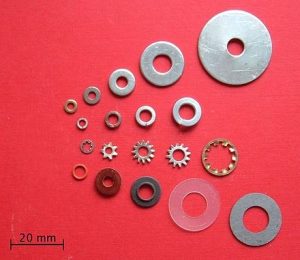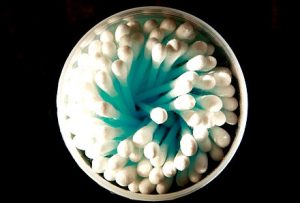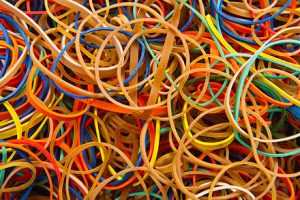A washer is a thin plate (typically disk-shaped) with a hole in the middle that is normally used to distribute the load of a threaded fastened such as a screw or nut. Other uses are as a spacer, spring , wear pad, preload indicating device, locking device, and to reduce vibration. Washers often have an outer diameter about twice their inner diameter, but this can vary quite widely.Washers are usually metal or plastic. High-quality bolted joints require hardened steel washers to prevent the loss of pre-load due to Brinelling after the torque is applied.Rubber or fiber gaskets used in taps to stop the flow of water are sometimes referred to colloquially as washers; but, while they may look similar, washers and gaskets are usually designed for different functions and made differently. Washers are also important for preventing galvanic corrosion, particularly by insulating steel screws from aluminium surfaces. The origin of the word is unknown; the first recorded use of the word was in 1346, however, the first time its definition was recorded was in 1611. Washers can be categorized into three types;
- Plain washers, which spread a load, and prevent damage to the surface being fixed, or provide some sort of insulation such as electrical
- Spring washers, which have axial flexibility and are used to prevent fastening or loosening due to vibrations
- Locking washers, which prevent fastening or loosening by preventing unscrewing rotation of the fastening device; locking washers are usually also spring washers.
Video showing how washers are made:
Cotton swabs or cotton buds consist of a small wad of cotton wrapped around one or both ends of a short rod, usually made of either wood, rolled paper or plastic. They are commonly used in a variety of applications including first aid, cosmetic application, cleaning, and arts and crafts. The cotton swab is a tool invented in the 1920s by Leo Gerstanzang after he watched his wife attach wads of cotton to toothpicks. His product, which he named “Baby Gays”, went on to become the most widely sold brand name, “Q-tips”, with the Q standing for “quality”. The term “Q-tips” is often used as a trademark for cotton swabs in the USA and Canada. The Q-tips brand is owned by Unilever and had over $200 million in sales in the US in 2014. Although doctors have said for years that use of the cotton swab for ear cleaning or scratching is not safe, such use remains the most common. The traditional cotton swab has a single tip on a wooden handle, and these are still often used, especially in medical settings. They are usually relatively long, about six inches. These often are packaged sterile, one or two to a paper or plastic sleeve. The advantage of the paper sleeve and the wooden handle is that the package can be autoclaved to be sterilized. Cotton swabs manufactured for home use are usually shorter, about three inches long, and usually double-tipped. The handles were first made of wood, then made of rolled paper, which is still most common. They are often sold in large quantities, 100 or more to a container. Plastic swab stems exist in a wide variety of colors, such as blue, pink or green. However, the cotton itself is traditionally white.
Video of how they were made:
A rubber band is a loop of rubber, usually ring shaped, and commonly used to hold multiple objects together. The rubber band was patented in England on March 17, 1845, by Stephan Perry. Most rubber bands are manufactured out of natural rubber, and are sold in a variety of sizes. Rubber bands are made by extruding the rubber into a long tube to provide its general shape, putting the tubes on mandrels, curing the rubber with heat, and then slicing it across the width of the tube into little bands.This causes the tube to split into multiple sections, creating a rubber band. Today about three quarters of the rubber in production is a synthetic product made from crude oil. World War II cut the United States off from rubber supplies worldwide, and they stepped up production of synthetic rubber for use in the war effort. There are about 20 grades of synthetic rubber and the intended end use determines selection. In general, to make synthetic rubber, byproducts of petroleum refining called butadiene and styrene are combined in a reactor containing soapsuds. A milky looking liquid latex results. The latex is coagulated from the liquid and results in rubber “crumbs” that are purchased by manufacturers and melted into numerous products. There is only one kind of natural rubber. Because the rubber plant only thrives in hot, damp regions near the equator, so 90% of true rubber production today occurs in the Southeast Asian countries of Malaysia and Thailand and in Indonesia. Indonesia’s production has dropped in recent years and new plantations were started in Africa to take up the slack.
Video if how they are made:


